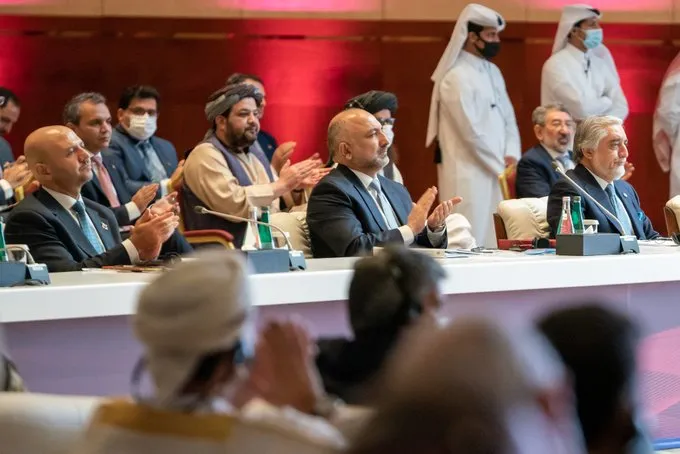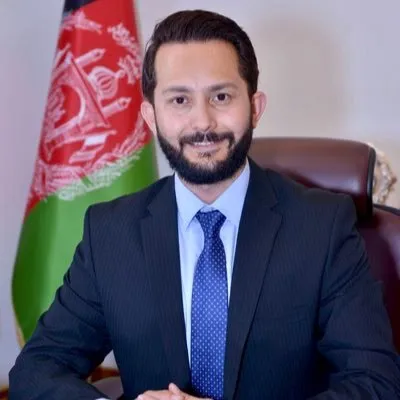
The ongoing peace talks between the Islamic Republic of Afghanistan and the Taliban in Qatar comes in the backdrop of certain epochal events that may change the course of the 21st century. On the one hand, the catastrophic Covid-19 pandemic caught the entire world off-guard, but on the other hand, humanity witnessed unprecedented unanimity against adversity. A similar chorus echoed that set the stage for these extant talks, intended to herald a new era of stable and sustainable peace in Afghanistan after four decades of war and bloodshed. Furthermore, an identical voicing was replicated regional and globally because of Afghanistan’s determined and resolute efforts to forge consensus; it’s accentuation is timely as the concerted international attempt to endorse Afghan narrative vis-a-vis the Taliban movement not only strikes consonance with the aspirations of the Afghan people, but it also has the potential to immensely contribute toward thriving and peaceful region and the world.
The upcoming Geneva donor conference will present another window of opportunity for all stakeholders of Afghan peace to showcase solidarity amid the reconciliation process. For the Taliban movement, this golden opportunity should be seized by doing away with all kinds of violence, upholding a ceasefire and acknowledging the new Afghanistan. It is also very important that Afghanistan’s allies endorse an End-State, acceptable to the people of Afghanistan, the region and the world.
Quintessential upshot
It is of paramount importance to understand that the national, regional, and international consensus, and confidence-building measures undertaken by the government of Afghanistan are the derivatives of constitutional democracy that Afghanistan accomplished after the fall of the Taliban movement in 2001. Commensurately, the constitutional democracy gave rise to empowered, vigilant, and vigorous civil societies and educated demographic dividend that not only bolstered the accountability of the administrative machinery of the country but also directed the leadership toward achieving the longing aspirations of the Afghan people. With such a background that will serve as the fulcrum of any peace deal, the hopes are at new heights, yet grounded in the practicalities of the regional dynamics.
Putting the stopper on a four-decade-old war
Since the Soviet invasion of Afghanistan, the country has witnessed an obdurate, dastardly, and diabolical carnage. Things invariably changed in the post-2001 era in terms of the establishment of the constitution, strengthening of democratic principles, the economic surge and so on. However, the violence abashedly unleashed continued killing innocent lives in the country. Since 2001, more than 111,000 people have lost their priceless lives. Similarly, the international community that invested in blood and treasure, while ensuring security in Afghanistan, has suffered some heavy casualties over the last 19 years. Furthermore, this unnecessary war not only resulted in the casualties for the Afghan civilians and Afghan National Defense and Security Forces (ANDSF), who are bravely fighting more than 20 terrorist groups at various forefronts, but it also resulted in mass displacement of thousands of citizens within the country and abroad.
Laying the foundation
Considering the costs of an ugly and unnecessary war, the government of Afghanistan undertook numerous initiatives to form domestic, regional and global consensus for the peace talks. The government successfully forged consensus with 20 regional and 20 international key players, including India. Further, copious confidence-building measures were undertaken such as the organization of Consultative Peace Loya Jirga — a 3,000-member assembly from diverse sections of the Afghan population including scholars, women representatives, youth activists, civil societies — and the release of around 5,500 Taliban insurgents. Later, a 21-member peace negotiating team was created, which once again comprised members from various parts across the country, representing politicians, Islamic scholars, women, youth, and other diverse members of the Afghan population. The team that comprises of four women is in Qatar now, speaking face to face with the Taliban.
India’s high stakes in new Afghanistan
Afghanistan has made drastic strides in the last two decades, and the contribution of its international allies, specially the US, the EU and India, in this is absolutely commendable. The pool of human capital, with young demographic dividend, has transformed into motivated citizens eager to make positive changes socially, politically, culturally, and economically. The core notion of democracy has strengthened with people actively participating in the Afghan polity and consolidating checks-and-balances. Today, there are hundreds of independent media outlets operating actively in the country; hundreds of schools and universities are enrolling students from every corner of the land, women participation in Afghan society is at new heights with around 27 percent MPs in the parliament being women. The female student enrollment ratio has increased manifolds with gross enrollment reaching over 83 percent. The GDP of the country has reached well over $18 billion in 2019 from less than $3 billion in 2001. The ANDSF has transformed into a professional, well-trained force in warfare tactics, while incorporating cutting-edge technology in its arsenal.
However, the key role played by our international partners in contributing towards our success as a nation cannot be overemphasized. India, being one of the strategic and largest trading partners of Afghanistan, has spent over $3 billion in rebuilding and reconstruction efforts in the country. As a nation with which Afghanistan not only engages economically and politically, but also because of the shared common values, the cultural thread that defines the contours of our bond is unique. India’s educational initiatives to give scholarships to Afghan students is another celebrated step, amongst many others. Since 2003, more than 70,000 Afghan students have graduated from India and there are currently around 17,000 Afghan students studying across various Indian states. Even during testing times of the Covid-19 pandemic, Afghanistan-India relationship continued the feat of ever-boosting bond, where India provided 75,000 tonnes of wheat to ensure food security while also providing essential critical drugs.
Further, India’s firm stand to back the narrative of the new Afghanistan is well acknowledged among Afghans. During the inaugural ceremony of the Qatar talks, India reiterated its call for an Afghan-led, Afghan-owned, and Afghan-controlled peace negotiations, which is considered extremely significant and important by the Afghan government. Its steadfast support in reaching the End-State is also vital from the Indian perspective as this will bolster India’s regional security infrastructure. Considering India’s growing global heft, it would be worth considering that New Delhi’s advocacy for an Afghan narrative both regionally and globally will reap dividends for the entire South Asian region.
Conclusion
The Taliban has to acknowledge the ground realities of the new Afghanistan, stop violence and embrace humanitarian ceasefire if they truly intend to accomplish enduring peace in the country. This would ensue their integration and assimilation in an Afghan society as rightful citizens. For the Islamic Republic of Afghanistan, the preservation of the constitutional democracy that delineates the rights of all Afghan citizens, its corollaries, and the gains of the last 19 years are extremely important. The End-State, acceptable to the Afghans, the region, and the world, will reap immense benefits for all stakeholders. The global mobilization for the Afghan peace process that is in line with the aspirations of Afghans has the potential to write a new chapter in world history. And with that, Afghanistan will once again become an economic hub and a bridge between Central and South Asia that will connect and help transit values, ideas and commodities, and boast itself as a symbol of cooperation rather than confrontation.
The views expressed above belong to the author(s). ORF research and analyses now available on Telegram! Click here to access our curated content — blogs, longforms and interviews.



 The ongoing peace talks between the Islamic Republic of Afghanistan and the Taliban in Qatar comes in the backdrop of certain epochal events that may change the course of the 21st century. On the one hand, the catastrophic Covid-19 pandemic caught the entire world off-guard, but on the other hand, humanity witnessed unprecedented unanimity against adversity. A similar chorus echoed that set the stage for these extant talks, intended to herald a new era of stable and sustainable peace in Afghanistan after four decades of war and bloodshed. Furthermore, an identical voicing was replicated regional and globally because of Afghanistan’s determined and resolute efforts to forge consensus; it’s accentuation is timely as the concerted international attempt to endorse Afghan narrative vis-a-vis the Taliban movement not only strikes consonance with the aspirations of the Afghan people, but it also has the potential to immensely contribute toward thriving and peaceful region and the world.
The upcoming Geneva donor conference will present another window of opportunity for all stakeholders of Afghan peace to showcase solidarity amid the reconciliation process. For the Taliban movement, this golden opportunity should be seized by doing away with all kinds of violence, upholding a ceasefire and acknowledging the new Afghanistan. It is also very important that Afghanistan’s allies endorse an End-State, acceptable to the people of Afghanistan, the region and the world.
The ongoing peace talks between the Islamic Republic of Afghanistan and the Taliban in Qatar comes in the backdrop of certain epochal events that may change the course of the 21st century. On the one hand, the catastrophic Covid-19 pandemic caught the entire world off-guard, but on the other hand, humanity witnessed unprecedented unanimity against adversity. A similar chorus echoed that set the stage for these extant talks, intended to herald a new era of stable and sustainable peace in Afghanistan after four decades of war and bloodshed. Furthermore, an identical voicing was replicated regional and globally because of Afghanistan’s determined and resolute efforts to forge consensus; it’s accentuation is timely as the concerted international attempt to endorse Afghan narrative vis-a-vis the Taliban movement not only strikes consonance with the aspirations of the Afghan people, but it also has the potential to immensely contribute toward thriving and peaceful region and the world.
The upcoming Geneva donor conference will present another window of opportunity for all stakeholders of Afghan peace to showcase solidarity amid the reconciliation process. For the Taliban movement, this golden opportunity should be seized by doing away with all kinds of violence, upholding a ceasefire and acknowledging the new Afghanistan. It is also very important that Afghanistan’s allies endorse an End-State, acceptable to the people of Afghanistan, the region and the world.
 PREV
PREV


